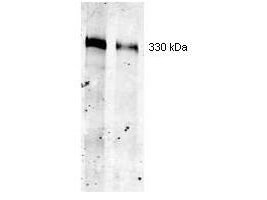Anti-Thyroglobulin (MOUSE) Monoclonal Antibody
Thyroglobulin Antibody
- SPECIFICATION
- CITATIONS
- PROTOCOLS
- BACKGROUND

| Host | Mouse |
|---|---|
| Conjugate | Unconjugated |
| Target Species | Human |
| Reactivity | Rat, Human, Mouse, Dog |
| Clonality | Monoclonal |
Application
| WB, IHC, E, I, LCI |
| Application Note | Anti-Thyroglobulin antibody has been tested by western blot and is suitable for the detection of thyroglobulin in ELISA, immunohistochemistry, and immunoprecipitation. For immunohistochemistry, both frozen sections and formalin fixed, paraffin-embedded tissue sections can be used without epitope retrieval or enzyme digestion. This antibody is specific for the 330 kDa thyroglobulin protein. Thyroglobulin shows a cytoplasmic localization. Thyroid tissue can be used as a positive control. |
| Physical State | Liquid (sterile filtered) |
| Buffer | 0.02 M Potassium Phosphate, 0.5 M Sodium Chloride, pH 7.2 |
| Immunogen | This protein A purified monoclonal antibody was produced by repeated immunizations with human thyroglobulin protein. |
| Preservative | 0.01% (w/v) Sodium Azide |
| Gene ID | 7038 |
|---|---|
| Other Names | 7038 |
| Purity | This protein A purified mouse monoclonal antibody reacts specifically with thyroglobulin in human tissues. The antibody recognizes a 330-kDa band corresponding to thyroglobulin. Cross reactivity with thyroglobulin from mouse, rat and dog will occur. Cross reactivity with thyroglobulin from other sources has not been determined. |
| Storage Condition | Store vial at -20° C prior to opening. Aliquot contents and freeze at -20° C or below for extended storage. Avoid cycles of freezing and thawing. Centrifuge product if not completely clear after standing at room temperature. This product is stable for several weeks at 4° C as an undiluted liquid. Dilute only prior to immediate use. |
| Precautions Note | This product is for research use only and is not intended for therapeutic or diagnostic applications. |
| Name | TG (HGNC:11764) |
|---|---|
| Function | Acts as a substrate for the production of iodinated thyroid hormones thyroxine (T4) and triiodothyronine (T3) (PubMed:17532758, PubMed:32025030). The synthesis of T3 and T4 involves iodination of selected tyrosine residues of TG/thyroglobulin followed by their oxidative coupling in the thyroid follicle lumen (PubMed:32025030). Following TG re-internalization and lysosomal-mediated proteolysis, T3 and T4 are released from the polypeptide backbone leading to their secretion into the bloodstream (PubMed:32025030). One dimer produces 7 thyroid hormone molecules (PubMed:32025030). |
| Cellular Location | Secreted. Note=Secreted into the thyroid follicle lumen (PubMed:19509106). Localizes to colloid globules, a structure formed in the thyroid follicle lumen consisting of cross-linked TG arranged in concentric layers (PubMed:11082042, PubMed:8626858). |
| Tissue Location | Specifically expressed in the thyroid gland. |

Thousands of laboratories across the world have published research that depended on the performance of antibodies from Abcepta to advance their research. Check out links to articles that cite our products in major peer-reviewed journals, organized by research category.
info@abcepta.com, and receive a free "I Love Antibodies" mug.
Provided below are standard protocols that you may find useful for product applications.
Background
Thyroglobulin (Tg) is synthesized by the follicular epithelial cells of the thyroid and secreted from the thyroid gland with the stimulation of TSH and/or thyroid stimulating immunoglobulins. Thyroglobulin is a prognostic marker for Graves` disease. Thyroglobulin antibody has been useful in the positive identification of thyroid carcinomas of the papillary and follicular types.
If you have used an Abcepta product and would like to share how it has performed, please click on the "Submit Review" button and provide the requested information. Our staff will examine and post your review and contact you if needed.
If you have any additional inquiries please email technical services at tech@abcepta.com.













 Foundational characteristics of cancer include proliferation, angiogenesis, migration, evasion of apoptosis, and cellular immortality. Find key markers for these cellular processes and antibodies to detect them.
Foundational characteristics of cancer include proliferation, angiogenesis, migration, evasion of apoptosis, and cellular immortality. Find key markers for these cellular processes and antibodies to detect them. The SUMOplot™ Analysis Program predicts and scores sumoylation sites in your protein. SUMOylation is a post-translational modification involved in various cellular processes, such as nuclear-cytosolic transport, transcriptional regulation, apoptosis, protein stability, response to stress, and progression through the cell cycle.
The SUMOplot™ Analysis Program predicts and scores sumoylation sites in your protein. SUMOylation is a post-translational modification involved in various cellular processes, such as nuclear-cytosolic transport, transcriptional regulation, apoptosis, protein stability, response to stress, and progression through the cell cycle. The Autophagy Receptor Motif Plotter predicts and scores autophagy receptor binding sites in your protein. Identifying proteins connected to this pathway is critical to understanding the role of autophagy in physiological as well as pathological processes such as development, differentiation, neurodegenerative diseases, stress, infection, and cancer.
The Autophagy Receptor Motif Plotter predicts and scores autophagy receptor binding sites in your protein. Identifying proteins connected to this pathway is critical to understanding the role of autophagy in physiological as well as pathological processes such as development, differentiation, neurodegenerative diseases, stress, infection, and cancer.


